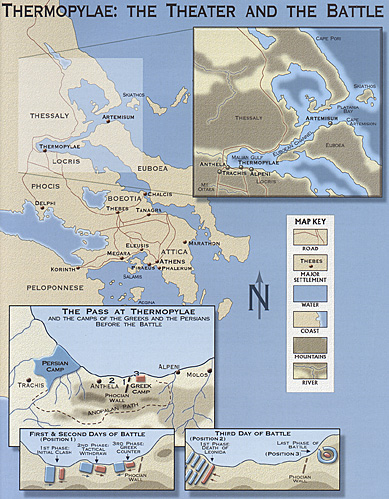 When Xerxes led his massive Persian army across the boat bridges at the Hellespont, he could only have imagined another campaign of conquest. Looking at his massive army of well over 100,000 as they marched along the mile-long bridges, he truly was the "Great King" who controlled Asia Minor and Egypt. Gathering against him were the city-states of Greece, chief among them - Sparta and Athens. To avenge the defeat of his father, Darius I, at Marathon, Xerxes had gathered together a vast army and navy that would crush the Greeks in both areas. So, it must have seemed in May of 480 B.C.
When Xerxes led his massive Persian army across the boat bridges at the Hellespont, he could only have imagined another campaign of conquest. Looking at his massive army of well over 100,000 as they marched along the mile-long bridges, he truly was the "Great King" who controlled Asia Minor and Egypt. Gathering against him were the city-states of Greece, chief among them - Sparta and Athens. To avenge the defeat of his father, Darius I, at Marathon, Xerxes had gathered together a vast army and navy that would crush the Greeks in both areas. So, it must have seemed in May of 480 B.C.
Opposing the Persian might were those Greek states that decided to stand up to the Persian invasion. Sparta was renowned for its army, while Athens dominated the waters of the Aegean with its fleet. When hastily constructing their common defense, it was decided that Leonidas, one of the Spartan kings, would lead an advance force to the Pass of Thermopylae where he would conduct a holding action, while the Athenian navy built up and attempted to destroy the Persian navy. Leonidas led a force of 4,000, made up largely of troops from the Peloponnese. Only 300 Spartans followed him because of religious ceremonies being held in Sparta at the time. This small force marched off on its forlorn mission, knowing full well that its position at the front would not hold forever. Along the way, soldiers from other Greek cities would join to expand the force to 8,000.
The pass at Thermopylae (the Hot Gate) was chosen because of the defensive position that it offered. On one side were steep cliffs that eventually merged with the towering Mount Kallidromos, which rose in the near distance. On the other side was the water barrier of the Gulf of Malian. In between lay the pass, narrowing at times to twenty or thirty feet across. It was a strong position, with one weakness. Through the mountains there was a path, decidedly difficult to use, but nonetheless there.
Across this path, an enemy could circumvent the pass. Leonidas felt its threat serious enough to deploy the thousand strong force of the Phocians. He then chose the Middle Gate area of the pass as his place for the battle to come. Here at an earlier time, the Phocians had built a stone wall to defend against their northern neighbors, the Thessalians. Leonidas chose this spot because, while wider than other areas of the pass, the steep walls and the waters of the Malian Gulf created an area where he would not have to worry as much about his flanks. By the time the Persian army would reach this area, it would gleam with the shields and spears of a united Greece, led by Sparta.
At Persepolis, Xerxes described himself in an inscription as "Xerxes, the King, King of Kings." Everything in his life had led him to this conclusion. The oldest son of Darius by the elder daughter of Cyrus, he was 38 at the time of the invasion. He controlled one of the largest empires that mankind had known and was intent on expanding into Europe. Xerxes was a devout man, who believed in the teachings of Zoroaster. Xerxes was no friend of polytheism, as his crackdown of the Egyptian pantheon of gods showed. He saw himself as Ahuramazda's representative on earth. As with many Eastern kings, he saw himself as the "one lord of Many." Unlike his father, Darius, who had been tolerant of other religions, Xerxes saw it as his duty to enforce the commands of Zoroaster. Greece would be another area where conquest would lead to a religious truth for Xerxes and ominously for the Greeks, as well. In the eyes of the Greeks, Xerxes must have seemed the epitome of the Eastern despot. Herodotus tells the story of Xerxes having the Hellespont flogged when one of the boat bridges broke. He said this was Xerxes warning to Poseidon that Xerxes would not pay tribute to the gods, that Xerxes was more powerful. Whether there is any truth or not, it demonstrates the Greek view of the imperious Xerxes.
Battle of Thermopylae
- Introduction
The Persian Army
The Greek Army
The Battle
Jumbo Map of Operations (extremely slow: 486K)
Jumbo Map of Thermopylae Pass (extremely slow: 466K)
Back to Table of Contents -- Against the Odds vol. 2 no. 2
Back to Against the Odds List of Issues
Back to MagWeb Magazine List
© Copyright 2003 by LPS.
This article appears in MagWeb.com (Magazine Web) on the Internet World Wide Web.
Other articles from military history and related magazines are available at http://www.magweb.com
* Buy this back issue or subscribe to Against the Odds direct from LPS.
